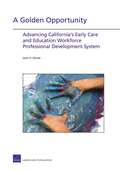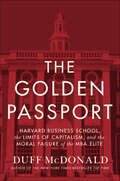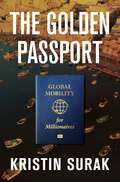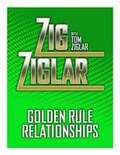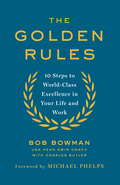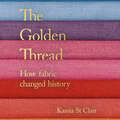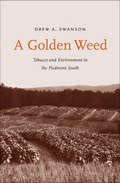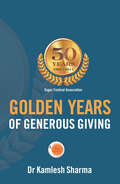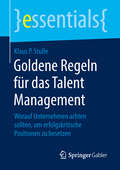- Table View
- List View
The Golden Leaf: How Tobacco Shaped Cuba and the Atlantic World
by Charlotte CosnerA Choice Reviews Editors' Pick Through the rise and fall of empires, ideologies, and economies, tobacco grown on the tiny island of Cuba has remained an enduring symbol of pleasure and extravagance. Cultivated as one of the first reliable commodities for those inhabitants who remained after conquistadors moved on in search of a mythical wellspring of gold, tobacco quickly became crucial to the support of the swelling Spanish Empire in the seventeenth and eighteenth centuries. Eventually, however, tobacco became one of the final stabilizing forces in the empire, and it ultimately proved more resilient than the best laid plans of kings and queens. Tobacco, and those whose livelihoods depended on it, shrugged off the Empire's collapse and pressed on into the twentieth century as an economic force any state or political power must reckon with. Cosner explores the history of this golden leaf through the personal narratives of farmers, bureaucrats, and laborers, all struggling to build an independent and lucrative economic engine. Through conquest, rebellion, colonial and imperial schemes, and the eventual Communist revolution, Cuban tobacco and cigars became a luxury item that commanded loyalty that defied mere borders or embargoes. Ultimately, The Golden Leaf is a story of two carefully cultivated products: Cuban tobacco, and its lofty reputation.
"Golden Leash" Pay for Directors at The Dow Chemical Company
by Ian D Gow Neeraj Goyal Suraj SrinivasanIn November 2014, The Dow Chemical Company was faced with the prospect of a proxy battle with prominent hedge fund and activist investor Third Point Management. The activist had criticized Dow's recent performance and advocated that the company split itself to maximize its potential. The activist also proposed two director candidates to join Dow's board. Third Point offered its director nominees what had come to be known as a "golden leash" incentive structure - a significant amount of incentive payment from the investor if the company performed well. Supporters and critics had weighed in on the pros and cons of such incentive schemes for corporate independent directors. Faced with the prospect of a proxy fight, Dow's board had to decide whether to invite the two directors on to the company's board knowing they came with the special payment scheme from the hedge fund.
A Golden Opportunity: Advancing California's Early Care and Education Workforce Professional Development System
by Lynn A. KarolyThis study focuses on the education, training, and ongoing professional development of early care and education (ECE) caregivers, teachers, and administrators who work with infants, toddlers, andpreschool-age children from birth to kindergarten entry in California. It aims to provide a comprehensive assessment of the state's ECE workforce professional development system and a set of recommendations for improving the system's effectiveness.
The Golden Passport: Harvard Business School, the Limits of Capitalism, and the Moral Failure of the MBA Elite
by Duff McDonaldFrom the New York Times–bestselling author of The Firm: “A massively detailed history of Harvard Business School . . . and a searing critique.” —Kirkus ReviewsWith The Firm, financial journalist Duff McDonald pulled back the curtain on consulting giant McKinsey & Company. In The Golden Passport, he reveals the inner workings of a singular nexus of power, ambition, and influence: Harvard Business School.Harvard University still occupies a unique place in the public’s imagination, but the Harvard Business School eclipsed its parent in terms of influence on modern society long ago. A Harvard degree guarantees respect. But a Harvard MBA near-guarantees entrance into Western capitalism’s most powerful realm—the corner office. And because the School shapes the way its powerful graduates think, its influence extends well beyond their own lives. It affects the organizations they command, and the economy they dominate.In addition to teasing out the essence of this exclusive, if not necessarily “secret” club, McDonald explores two important questions: Has the school failed at reaching the goal it set for itself in 1908—”the multiplication of men who will handle their current business problems in socially constructive ways”? Is HBS complicit in the moral failings of Western capitalism?At a time of soaring economic inequality and growing political unrest, this hard-hitting yet fair portrait offers a much-needed look at a profoundly influential institution. “Exploring how Harvard Business School became a ticket to the highest echelons of money, power, and influence, McDonald chronicles the school’s history in an irreverent, cynical, and frequently funny exposé of its pretensions.”—Publishers Weekly“Impressively researched . . . I suspect McDonald won’t be invited to campus anytime soon, but perhaps he should be: Agree with him or not, he deserves credit for raising questions that every business school needs to be asking.” —The New York Times
The Golden Passport: Global Mobility for Millionaires
by Kristin SurakThe first comprehensive on-the-ground investigation of the global market for citizenship, examining the wealthy elites who buy passports, the states and brokers who sell them, and the normalization of a once shadowy practice.Our lives are in countless ways defined by our citizenship. The country we belong to affects our rights, our travel possibilities, and ultimately our chances in life. Obtaining a new citizenship is rarely easy. But for those with the means—billionaires like Peter Thiel and Jho Low, but also countless unknown multimillionaires—it’s just a question of price.More than a dozen countries, many of them small islands in the Mediterranean, Caribbean, and South Pacific, sell citizenship to 50,000 people annually. Through six years of fieldwork on four continents, Kristin Surak discovered how the initially dubious sale of passports has transformed into a full-blown citizenship industry that thrives on global inequalities. Some “investor citizens” hope to parlay their new passport into visa-free travel—or use it as a stepping stone to residence in countries like the United States. Other buyers take out a new citizenship as an insurance policy or to escape state control at home. Almost none, though, intend to move to their selected country and live among their new compatriots, whose relationship with these global elites is complex.A groundbreaking study of a contentious practice that has become popular among the nouveaux riches, The Golden Passport takes readers from the details of the application process to the geopolitical hydraulics of the citizenship industry. It’s a business that thrives on uncertainty and imbalances of power between big, globalized economies and tiny states desperate for investment. In between are the fascinating stories of buyers, brokers, and sellers, all ready to profit from the citizenship trade.
The Golden Revolution
by John ButlerWhy the gold standard is due for a comebackA reserve currency can only function as such if there is a general consensus that it provides a stable store of value. Without this trust, money, no matter what form it takes, will be abandoned--either suddenly in a crisis, or gradually over time--in favor of something else. The Golden Revolution looks at how the world is rapidly moving toward some form of global metallic standard, in which money, at least in official, international transactions, is linked directly to gold, silver, or both.The practical reality of the transition to the coming global gold (or bimetallic) standard is going to be substantially different from the global fiat monetary and financial regime of today. It is not just money that is going to change. The nature and business of banking will also be affected, as will finance in general.Incisive and thoughtful, The Golden Revolution is a treatise on the broad effects of the current and future monetary structureLooks at why the world is headed inexorably back towards a metallic money standardExplores what the transition period might look like, including some historical examples of both orderly and disorderly transitionsExamines how the world of banking, finance, and investment, including asset valuation and portfolio management techniques, will work under a future gold standard and which industries, countries and markets are likely to benefit and which are likely to sufferFull of advice on how investors can profit and protect themselves during this critical time of change, the book knows that those who are prepared will prosper, while those who won't stand to lose it all.
Golden Rice: The Imperiled Birth of a GMO Superfood
by Ed RegisThe first book to tell the shocking story of Golden Rice, a genetically modified grain that provides essential Vitamin A and can save lives in developing countries—if only they were allowed to grow it.Ordinary white rice is nutrient poor; it consists of carbohydrates and little else. About one million people who subsist on rice become blind or die each year from vitamin A deficiency. Golden Rice, which was developed in the hopes of combatting that problem by a team of European scientists in the late '90s, was genetically modified to provide an essential nutrient that white rice lacks: beta-carotene, which is converted into vitamin A in the body. But twenty years later, this potentially sight- and life-saving miracle food still has not reached the populations most in need—and tens of millions of people in India, China, Bangladesh, and throughout South and Southeast Asia have gone blind or have died waiting. Supporters claim that the twenty-year delay in Golden Rice's introduction is an unconscionable crime against humanity. Critics have countered that the rice is a "hoax," that it is "fool's gold" and "propaganda for the genetic engineering industry." Here, science writer Ed Regis argues that Golden Rice is the world's most controversial, maligned, and misunderstood GMO. Regis tells the story of how the development, growth, and distribution of Golden Rice was delayed and repeatedly derailed by a complex but outdated set of operational guidelines and regulations imposed by the governments and sabotaged by anti-GMO activists in the very nations where the rice is most needed. Writing in a conversational style, Regis separates hyperbole from facts, overturning the myths, distortions, and urban legends about this uniquely promising superfood. Anyone interested in GMOs, social justice, or world hunger will find Golden Rice a compelling, sad, and maddening true-life science tale.
Golden Rule: The Investment Theory of Party Competition and the Logic of Money-Driven Political Systems (American Politics And Political Economy Ser.)
by Thomas Ferguson"To discover who rules, follow the gold." This is the argument of Golden Rule, a provocative, pungent history of modern American politics. Although the role big money plays in defining political outcomes has long been obvious to ordinary Americans, most pundits and scholars have virtually dismissed this assumption. Even in light of skyrocketing campaign costs, the belief that major financial interests primarily determine who parties nominate and where they stand on the issues—that, in effect, Democrats and Republicans are merely the left and right wings of the "Property Party"—has been ignored by most political scientists. Offering evidence ranging from the nineteenth century to the 1994 mid-term elections, Golden Rule shows that voters are "right on the money." Thomas Ferguson breaks completely with traditional voter centered accounts of party politics. In its place he outlines an "investment approach," in which powerful investors, not unorganized voters, dominate campaigns and elections. Because businesses "invest" in political parties and their candidates, changes in industrial structures—between large firms and sectors—can alter the agenda of party politics and the shape of public policy.Golden Rule presents revised versions of widely read essays in which Ferguson advanced and tested his theory, including his seminal study of the role played by capital intensive multinationals and international financiers in the New Deal. The chapter "Studies in Money Driven Politics" brings this aspect of American politics into better focus, along with other studies of Federal Reserve policy making and campaign finance in the 1936 election. Ferguson analyzes how a changing world economy and other social developments broke up the New Deal system in our own time, through careful studies of the 1988 and 1992 elections. The essay on 1992 contains an extended analysis of the emergence of the Clinton coalition and Ross Perot's dramatic independent insurgency. A postscript on the 1994 elections demonstrates the controlling impact of money on several key campaigns. This controversial work by a theorist of money and politics in the U.S. relates to issues in campaign finance reform, PACs, policymaking, public financing, and how today's elections work.
The Golden Rule
by Jim GibbonsEverything the independent investor needs to know to effectively invest in goldWith today's increasing economic uncertainties, a strong investment strategy is to put a portion of your net worth in gold. However, given investors' overall lack of knowledge about gold as an investment, as wealth insurance, or as a store of value, many are hesitant to enter this arena.That's why Jim Gibbons has created The Golden Rule. This book answers many questions, including: How do you purchase gold and in what form? Why gold now? When should you buy? And, most importantly, from whom? Throughout the book, Gibbons puts gold in perspective and shows you why it belongs in every investor's portfolio.Provides practical gold investment insights from New York Times bestsellers Peter Schiff, William Bonner, Doug Casey, Addison Wiggin, and James Turk as well as from leading experts in this field including: Congressman Ron Paul, Rick Rule, Adrian Day, and many othersDemystifies gold by putting it in the context of twenty-first century economic realitiesHighlights a variety of ways to invest in gold-from mining stocks to buying gold coins and bullionWith the financial markets more erratic than ever, gold appeals to investors looking for a safe haven for their assets. With The Golden Rule as your guide, you'll quickly learn how to make the best decisions possible with regards to this precious commodity.
Golden Rule Relationships
by Tom Ziglar Zig ZiglarIf you are hitting a relationship rough patch, it can be difficult to move forward. Sometimes people in relationships feel like all they are doing is focusing on the troubles in life - but for good reason. The thing is, relationships are oftentimes what complete people's lives. Therefore, when a relationship is hitting a rough patch, it can be quite difficult to think of anything else.Zig Ziglar tells about the importance of relationships in his book, Golden Rule Relationships and provides valuable insight for anybody in any relationship, from romantic to platonic. For anybody experiencing rough patches in their relationships, this classic Zig Ziglar book will be instrumental in helping to discover how you can go about sewing up the holes that may have begun to appear in your relationships.Here's some of what you'll learn:Why you can have everything in life you want if you will just help enough other people get what they wantWhy mutually beneficial relationships are the most long-lasting relationshipsThe importance of treating people with respect, even honorThe importance of giving total emotional involvement to the people you are in relationships withWhy you've got to be before you can do, and you've got to do before you can haveWhy it takes effort, commitment, and a leap of faith for any relationship to flourish
The Golden Rules: 10 Steps to World-Class Excellence in Your Life and Work
by Bob BowmanBob Bowman, best known as the coach for the record-breaking run of Michael Phelps, is one of the most successful coaches in Olympic history. The Golden Rules is his motivational book about winning in all walks of life and what you have to do to get there. He presents ten key concepts that all people should live by. Inside, illuminated by spirited anecdotes, Bowman will teach you how to get gold out of every day by setting goals and getting motivated to achieve them. He will explain that taking risks is the key to success in any pursuit, and coach you on how you can become more risk-tolerant.By following The Golden Rules, you will learn to visualise in order to achieve your goals, and that above all else, dedication to your training, your job, or whatever area it is you are seeking to triumph in is paramount for success.
Golden State: The Making of California
by Michael Hiltzik“Superb. Hiltzik makes a compelling case that California is the heartbeat of our nation.”—Douglas Brinkley, New York Times bestselling author of Silent Spring RevolutionFrom Pulitzer Prize winner Michael Hiltzik, a definitive new history of California—from the Spanish conquistadors to the Gold Rush to the state’s meteoric rise as a tech powerhouse and bulwark of progressivism—and of its indelible mark on the United States and the world.California has long reigned as the land of plenty, a place where the sun always shines and opportunity beckons. Even prior to its statehood in 1850, it captured the world’s imagination. We think of bearded prospectors lured by the promise of gold; we imagine its early embrace of immigrant labor during the railroad boom as prologue to its diverse social fabric today. But what lies underneath the myth is far more complicated.Thanks to extensive research by Michael Hiltzik, one of our longstanding voices on California, Golden State uncovers the unvarnished truth about the state we think we know well. From Spanish incursions into what became known as Alta California to the rise of Big Tech, the history of California is one of stark contradictions. In rich, previously overlooked detail, we see its earliest statesmen wreak havoc among native peoples while racing to draft their own constitution even ahead of statehood. Gold-hungry settlers venture into the Sierra foothills only to leave with little, while a handful of their suppliers turn themselves into millionaire railroad magnates. Wars erupt in the name of water as Los Angeles booms, and early efforts to tame the vast landscape create a haven for fossil fuel extraction and environmental conservation alike. Hollywood politicians stoke fear, contributing to a centuries-long tradition of anti-Asian violence, and, remarkably, legal redlining and free higher education take root together.Golden State brings a fresh critical eye to the origins of the state against which the rest of the country measures itself. From its very start, Hiltzik shows, the story of the United States was written in California.
The Golden Thread: How Fabric Changed History
by Kassia St Clair** A RADIO 4 BOOK OF THE WEEK **'Fascinating . . . The history of the world through the eye of a needle . . . I recommend this book to anyone' THE SPECTATOR'A charming, absorbing and history that takes us on a journey from the silk roads to sportswear, from ruffs to spacesuits . . . I devoured this quietly feminist book' SUNDAY TIMES'Joyful and beautiful' NATURE'Will make you rethink your relationship with fabric' ELLE DECORATIONAll textiles begin with a twist. From colourful 30,000-year old threads found on the floor of a Georgian cave to what the linen wrappings of Tutankhamun's mummy actually meant; from the Silk Roads to the woollen sails that helped the Vikings reach America 700 years before Columbus; from the lace ruffs that infuriated the puritans to the Indian calicoes and chintzes that powered the Industrial Revolution, our continuing reinvention of cloth tells fascinating stories of human ingenuity. When we talk of lives hanging by a thread, being interwoven, or part of the social fabric, we are part of a tradition that stretches back many thousands of years. Fabric has allowed us to achieve extraordinary things and survive in unlikely places, and this book shows you how -- and why.With a cast that includes Chinese empresses, Richard the Lionheart and Bing Crosby, Kassia St Clair takes us on the run with escaped slaves, climbing the slopes of Everest and moonwalking with astronauts. Running like a bright line through history, The Golden Thread offers an unforgettable adventure through our past, present and future.
The Golden Thread: How Fabric Changed History
by Kassia St Clair** A RADIO 4 BOOK OF THE WEEK **'Fascinating . . . The history of the world through the eye of a needle . . . I recommend this book to anyone' THE SPECTATOR'A charming, absorbing and history that takes us on a journey from the silk roads to sportswear, from ruffs to spacesuits . . . I devoured this quietly feminist book' SUNDAY TIMES'Joyful and beautiful' NATURE'Will make you rethink your relationship with fabric' ELLE DECORATIONAll textiles begin with a twist. From colourful 30,000-year old threads found on the floor of a Georgian cave to what the linen wrappings of Tutankhamun's mummy actually meant; from the Silk Roads to the woollen sails that helped the Vikings reach America 700 years before Columbus; from the lace ruffs that infuriated the puritans to the Indian calicoes and chintzes that powered the Industrial Revolution, our continuing reinvention of cloth tells fascinating stories of human ingenuity. When we talk of lives hanging by a thread, being interwoven, or part of the social fabric, we are part of a tradition that stretches back many thousands of years. Fabric has allowed us to achieve extraordinary things and survive in unlikely places, and this book shows you how -- and why.With a cast that includes Chinese empresses, Richard the Lionheart and Bing Crosby, Kassia St Clair takes us on the run with escaped slaves, climbing the slopes of Everest and moonwalking with astronauts. Running like a bright line through history, The Golden Thread offers an unforgettable adventure through our past, present and future.
The Golden Thread: How Fabric Changed History
by Kassia St ClairAs heard on BBC Radio 4's Book of the WeekA new history of ingenuity from the author of The Secret Lives of Colour.From the mummies of Ancient Egypt; via the silken dragon robes of Imperial China and the woollen sails of Viking longboats to the Indian calicoes and chintzes that powered the Industrial Revolution (and sparked more than one war); arriving finally at the lab-blended fibres that have allowed astronauts to moonwalk -- fabrics, manmade and natural, have changed and shaped the world we live in.In twelve fascinating chapters, Kassia St Clair lays out an alternative history of civilisation and human creativity. Wittily written and compellingly argued, this book will change the way you see the world.(P)2018 Hodder & Stoughton Limited
The Golden Triangle: Back in Business (A)
by William R. Kerr Joseph B. Fuller Manjari Raman Donald MaruyamaCase
A Golden Weed
by Dr Drew A. SwansonDrew A. Swanson has written an "environmental" history about a crop of great historical and economic significance: American tobacco. A preferred agricultural product for much of the South, the tobacco plant would ultimately degrade the land that nurtured it, but as the author provocatively argues, the choice of crop initially made perfect agrarian as well as financial sense for southern planters. Swanson, who brings to his narrative the experience of having grown up on a working Virginia tobacco farm, explores how one attempt at agricultural permanence went seriously awry. He weaves together social, agricultural, and cultural history of the Piedmont region and illustrates how ideas about race and landscape management became entangled under slavery and afterward. Challenging long-held perceptions, this innovative study examines not only the material relationships that connected crop, land, and people but also the justifications that encouraged tobacco farming in the region.
The Golden Years: How to plan a happy and financially secure retirement
by Jamie Nemtsas Drew MeredithWe call them the ‘ golden years' . Retirement these days can span 30-plus years, so we need to plan retirement as carefully as we plan other phases of our life that span three decades – our career, raising and educating children, and buying and paying off our home. This book helps you make this plan. It looks at the lifestyle you want to achieve in retirement, how to keep your money working for you when you are not working and how to set your affairs in order for the later part of your life when you inevitably become less independent. Most importantly, it helps you navigate the multiple challenges that will arise, with the benefit of the experience supporting those who have been there before.Packed with case studies from a career in financial advice, as well as practical and actionable insights, this book will educate, inspire and give you peace of mind as you plan for, transition to and live your best life in retirement.
Golden Years of Generous Giving: Sugar Festival Association – Lautoka - Fiji
by Dr Kamlesh SharmaThe Sugar Festival Association is incorporated under the Charitable Trusts Act (Cap 67) of Fiji. Its main aim is to raise funds for charitable purposes by organising the annual Sugar Festival and undertake projects that benefit the community as a whole. The Lautoka Sugar Festival is one of the largest in Fiji and its origin goes back to early 1961 when the first Festival was organised by the Lautoka Junior Chamber of Commerce (Lautoka Jaycees). The Festival continued as an annual event under the stewardship of Lautoka Jaycees until 1980 when it was announced that the running of the Festival would be handed over to a public committee. This resulted in the establishment of the Sugar Festival Association that is now responsible for organising the annual Festival on the foundation of generous goodwill and commitment of its volunteers and supporters.
Goldene Regeln für das Talent Management: Worauf Unternehmen achten sollten, um erfolgskritische Positionen zu besetzen (essentials)
by Klaus P. StulleKlaus P. Stulle vereint in diesem essential zwei Herangehensweisen an ein sehr zeitgemäßes Thema: Zum einen beschreibt er entlang konkreter Ergebnisse ein Instrument, mit dem der Reifegrad des Talent Managements im Unternehmen erfasst werden kann. Im zweiten Teil werden als getrennte Checkpoints zehn goldene Regeln vorgestellt, mit denen das vorhandene Talent Management dann weiter optimiert werden kann. Insofern finden Praktiker sowohl in Großunternehmen und Konzernen, aber auch im Mittelstand ganz konkrete Hinweise, mit denen die jeweilige Unternehmensrealität hinterfragt und vorangebracht werden kann.
Goldfinger: Charles W. Engelhard Jr. and Apartheid-era South Africa
by Geoffrey G. Jones Elliot R. BentonThis case considers the strategies of Charles W. Engelhard, an American mining magnate who made large investments in apartheid-era South Africa. Engelhard was widely believed to have been the model for the James Bond villan Auric Goldfinger. During the 1950s and 1960s Engelhard, who was well-connected with the leadership of the Democratic Party in the United States including President Lyndon B. Johnson, was one of the largest American investors in that country. His close relationship with Harry Oppenheimer, the head of the Anglo-American Corporation, gave him substantial influence within the South African business system. The case starts with anti-apartheid demonstrators protesting outside a ceremony awarding him a prize in Newark, New Jersey. It provides an opportunity to debate the political and ethical responsibilities of businesses in repressive regimes, and the challenges faced by entrepreneurs operating in countries with different value systems and political regimes.
Goldman Sachs: Making an Imprint in Impact Investing
by Shawn Cole Vikram Gandhi Caitlin Lindsay Reimers Brumme Lynn SchenkGoldman Sachs acquired Imprint Capital Advisors, a small firm that specialized in advising clients on environmental/social/governance (ESG) and impact investments. The founders sold Imprint with the belief that joining a global financial firm would help to scale impact investing, if not bring it into the mainstream. The case is set two years after the acquisition. It describes impact investing, the founding of Imprint, and its evolution from serving foundations and home offices to financial institutions, and its sale to and integration within Goldman Sachs. The founders consider the past two years and whether the acquisition has, in fact, help to scale ESG/impact investing.
Goldman Sachs
by Lisa J. EndlichThe history, mystique, and remarkable success of Goldman Sachs, the world's premier investment bank, are examined in unprecedented depth in this fascinating and authoritative study. Former Goldman Sachs Vice President Lisa Endlich draws on an insider's knowledge and access to all levels of management to bring to life this unique company that has long mystified financial players and pundits.The firm's spectacular ascent is traced in the context of its tenacious grip on its core values. Endlich shows how close client contact, teamwork, focus on long-term profitability rather than short-term opportunism, and the ability to recruit consistently some of the most talented people on Wall Street helped the firm generate a phenomenal $3 billion in pretax profits in 1997. And she describes in detail the monumental events of 1998 that shook Goldman Sachs and the financial world.Her book documents some of the most stunning accomplishments in modern American finance, as told through the careers of the gifted and insightful men who have led Goldman Sachs. It begins with Marcus Goldman, a German immigrant who in 1869 founded the firm in a lower Manhattan basement. After the turn of the century, we see his son Henry and his son-in-law Sam Sachs develop a full-service bank. Sidney Weinberg, a kid from the streets, was initially hired as an assistant porter and became senior partner in 1930. We watch him as he steers the firm through the aftermath of the Crash and raises the Goldman Sachs name to national prominence. When he leaves in 1969 the firm has a solid-gold reputation and a first-class list of clients. We see his successor, Gus Levy, a trading wizard and in his day the best-known man on Wall Street, urging greater risk, inventing block trading (which revolutionized the exchanges), and psychologically preparing Goldman Sachs for the complex and perilous financial world that was the 1980s.Endlich shows us how co-CEOs John Whitehead and John Weinberg turned the family firm into a highly professional international organization with a culture that was the envy of Wall Street. She shows as well how Steve Friedman and Robert Rubin brought the firm to the pinnacle of investment banking, increased annual profits from $900 million to $2.7 billion, and achieved dominance in most of the businesses in which the firm competes internationally. We see how Goldman Sachs weathered both an insider trading scandal and the fallout from its relationship with Robert Maxwell.We are taken to the present day, as Jon Corzine and Hank Paulson lead the firm out of turmoil to face the most important decision ever placed before the partnership--the question of a public sale. For many years the leadership wrestled with the issue behind closed doors. Now, against the backdrop of unforeseen events, we witness the passionate debate that engulfed the entire partnership. A rare and revealing look inside a great institution--the last private partnership on Wall Street--and inside the financial world at its highest levels.
Goldman Sachs: Anchoring Standards after the Financial Crisis
by Lisa Mazzanti Rajiv LalGoldman Sachs, a longtime venerable financial institution headquartered in New York City, had a partnership culture that was known to value its clients. But when the financial crisis hit in 2008 and Goldman Sachs emerged relatively unscathed, its public image took a large blow as people questioned the inner workings of the bank. To address the situation, Goldman Sachs CEO Lloyd Blankfein called for the creation of the Business Standards Committee (BSC) to carry out a rigorous introspection of the firm. This case explores the reactions of the executives at the bank over the short- and medium-term to public accusations and scrutiny and whether the implemented solutions devised by the BSC are sustainable. It details the themes of individual and collective accountability, reputational awareness, and client care.
Goldman Sachs: The 10,000 Women Initiative
by Catherine Ross Christopher Marquis V. Kasturi RanganGoldman Sachs' five-year, $100 million philanthropic initiative to provide practical business and management education to 10,000 women around the globe recently celebrated its first anniversary and over 1,200 women were either enrolled in, or graduated from sponsored certificate programs. The case describes the conception, development and implementation of the initiative and outlines some key strategic decisions facing the firm as they roll-out the program over the coming years. These include: how to organize the network of schools that deliver the educational services, how to determine the best outside partners to provide additional services for the women entrepreneurs, how to best assess the impact of the program, and finally the extent to which the initiative provides contributions to the long-term strategy of the firm.


